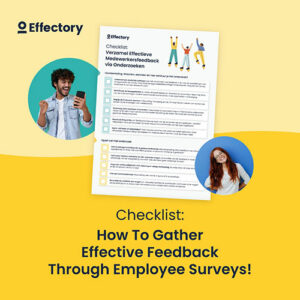Attracting and retaining good personnel is a problem for many companies; we have shifted from an employer to an employee market. Knowing what’s happening amongst employees is more important than ever. Tech startups with employee feedback apps are now springing up like mushrooms. However, many of them focus primarily on technology, without paying attention to “touch”. And that is at the expense of the result, both for startups and the companies that use their services.
Only tech and touch employee feedback ensures real impact

For companies, it is a noble goal to enable employees to use their full potential. After all, the organization itself and its employees benefit from this. An important tool here is to check how employees feel and to measure how enthusiastic and involved they are. Personnel policy is drawn up on the basis of this information to ensure that employees actually use their potential. Feedback from employees is therefore a very important indicator which you can collect through apps and questionnaires. But as you know, just making an app available is no guarantee of success. Quite the opposite.
Pure SaaS – low impact
Getting employee feedback is done primarily by all kinds of apps and tools from new tech players in the field. Consider, for example, a questionnaire that immediately pops up on your phone when you have just come out of a meeting with the question: “What did you think of this meeting?” That’s fun once, but after a number of such questions, employees have had quite enough of it. And what about a voting button, when logging out or at the exit with the question: “How did you like your day?” After a few times, employees also find that irritating. They are already swamped every day by online tools, apps and questionnaires to complete.
The risk of instrumental / technical approach in employee feedback
In addition to this tool fatigue among employees, the instrumental, technical approach to retrieving feedback from the organization doesn’t work either, because app builders by definition assume a perfect organization. An organization where the CEO and the managers know exactly what they want to know about employees. Which buttons they should turn to improve their enthusiasm and involvement. An organization where everyone wants to participate in research and is curious about the results. Managers who know exactly how to discuss the results, etcetera. However, the reality is more complicated. For example, managers are often afraid of employee feedback. Results are often waved away or brushed under the carpet, because people cannot or will not change. And this is demotivating for the employees who work there.
How to gather feedback from your employees
The definitive checklist for creating your employee engagement survey.
DownloadFurthermore, it often lacks tools to ensure that feedback becomes truly embedded in the organization, so that it leads to a serious impact. Many tech companies consist of a large development team and a marketing/sales department. They serve the customers according to a SaaS model and possibly hire a customer success manager, if this model proves to be too skimpy. So, they don’t really have room to pay attention to the touch side of employee feedback. The guiding of management, HR and middle management to get started with the results. It is therefore not surprising that their products have little or no impact on the ultimate work experience of employees. In fact, the confidence that the organization handles feedback well may decrease as a result.
Tech and touch
For the organizations that want the enthusiasm of their employees to increase, for example, from a 5.4 to a 7.4, a change in process is necessary. However, that doesn’t mean that you must constantly harass all the employees with all kinds of different tools and an endless stream of questionnaires to gather information. You actually want to ask questions as little as possible, not too often and as easily as possible. This can be achieved with an app and gamification, but it’s important to keep the focus on the final impact.
Encouraging feedback from employees
By setting up a good feedback landscape for customers, you can ask the right employees, at the right times, the right questions, that really help the organization. Employees then feel heard instead of being “processed”. It is an art to do this without annoying employees, or without the results of the feedback subsequently disappearing in the bin.
You can do this, for example, with an approach where after an initial inventory, you divide the organization. You visit all the teams and organizational layers to see how well they’re doing. You give advice to the successful teams; celebrate your successes. You give the mediocre teams the results and advice in the areas they can improve and only in the teams where things aren’t going well, intervene in a targeted way. After all, this is where you can achieve the biggest improvements.
Finally, make sure that the feedback you collect at a central level is actually used for implementing improvements. And communicate those improvements, linking them to the feedback you have received. Make sure that your organization as a whole is raised to a 7.4. So, focus not only on tech, but also on the touch! This method is much more effective and leads to a real impact.
Employee Engagement
Increase employee engagement through action-oriented feedback. Using a single platform, you can collect reliable data, analyze the results, and share insights.
view employee survey solution